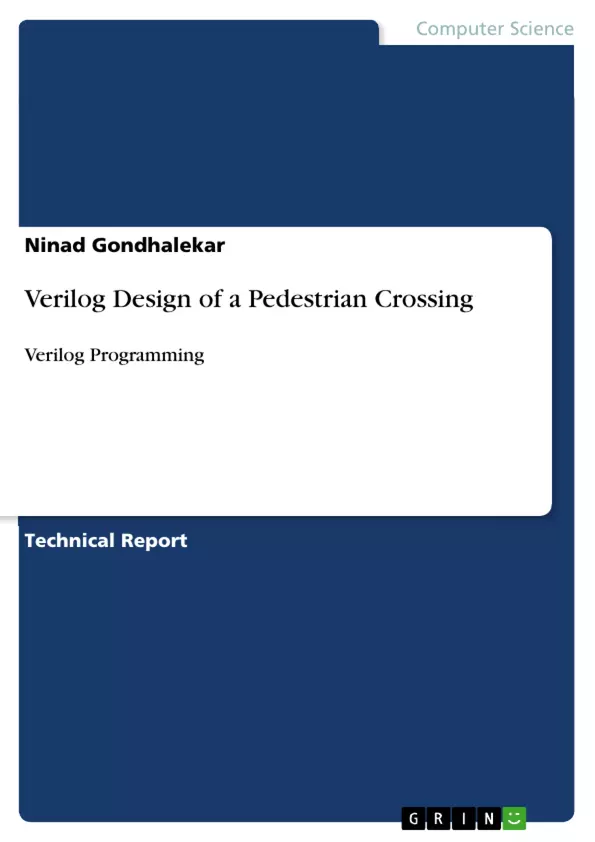This laboratory results shows the Verilog hardware design language (HDL) and Finite State Machine to control a pedestrian crossing controller and its modification. In session-1, simple Verilog program is simulated and then tested on Coolrunner-II board. In this session the controller three outside world input which are Clock (CLK), Reset (RESET), Pedestrian (PED) and three output which are Red light (RED), Amber light (AMBER), Green light (GREEN).
In session-2, some modifications are done on Verilog program used in session-1 and then again simulated and tested on Coolrunner-II board. In this session the controller 7 segment displays is used to see changes in pelstate, while running modified Verilog program on Coolrunner-II board and Carsensor outside world input has been introduced in modified Verilog program. In this modified Verilog program, number of pelstate has been increased.
This laboratory session provides a good opportunity to learn Xilinx ISE Design Suit software and introduce to Coolrunner-II board.
Inhaltsverzeichnis (Table of Contents)
- Introduction
- Session - I
- Block diagram of finite state machine of pelican crossing controller used in session I is shown in figure 1.
- Verilog modules and 'ucf' file for session - I
- State Diagram of Session - I
- Simulation for Session - I
- CPLD Fitting Report for Session — I
- Working of Program on Coolrunner – II
- Session II
- State Diagram for Session - II
- Verilog modules and 'ucf' file for session - II
- Simulation for Session - II
- CPLD Fitting Report for Session
- Working of Program on Coolrunner - II
Zielsetzung und Themenschwerpunkte (Objectives and Key Themes)
This report details the Verilog hardware design language (HDL) and Finite State Machine implementation of a pedestrian crossing controller, along with its modifications. The report focuses on simulating and testing the design using the Coolrunner-II board. Key themes explored in this report include: * **Finite State Machine Implementation**: The report demonstrates the use of finite state machines (FSMs) for controlling the pedestrian crossing system. * **Verilog HDL**: The use of Verilog hardware description language for implementing the FSM and related logic is a key focus. * **Coolrunner-II Board**: The report explores the practical implementation of the designed system on a Coolrunner-II board. * **Simulation and Testing**: The report emphasizes the importance of thorough simulation and testing of the Verilog design. * **Modifications and Enhancements**: The report examines modifications and enhancements made to the basic pedestrian crossing controller design in the second session.Zusammenfassung der Kapitel (Chapter Summaries)
Introduction
This section provides an overview of the report's purpose, which is to demonstrate the design and implementation of a pedestrian crossing controller using Verilog HDL and finite state machines. It introduces the two sessions, outlining the key elements of each, including inputs, outputs, and modifications.Session - I
This section details the initial design of the pedestrian crossing controller. It includes: * A block diagram illustrating the structure of the finite state machine, its inputs, outputs, and internal components like counters. * A description of the Verilog modules and 'ucf' file, which are used to connect and configure the system. * An explanation of the state diagram, showcasing the states of the controller and the transitions between them. * Information regarding the simulation of the design, verifying its behavior. * A report on the fitting of the design onto a Coolrunner-II CPLD, demonstrating the feasibility of implementation.Session II
This section focuses on modifications made to the design implemented in Session I. It covers: * An updated state diagram for the modified controller. * The Verilog modules and 'ucf' file for the modified design. * Simulation results for the enhanced design. * A CPLD fitting report for the modified version.Schlüsselwörter (Keywords)
The report focuses on the practical application of Verilog HDL for the design of a pedestrian crossing controller using a finite state machine. Key terms include: Verilog HDL, finite state machine, Coolrunner-II board, simulation, testing, CPLD, pedestrian crossing, state diagram, and modifications.- Arbeit zitieren
- Ninad Gondhalekar (Autor:in), 2013, Verilog Design of a Pedestrian Crossing, München, GRIN Verlag, https://www.hausarbeiten.de/document/284210


